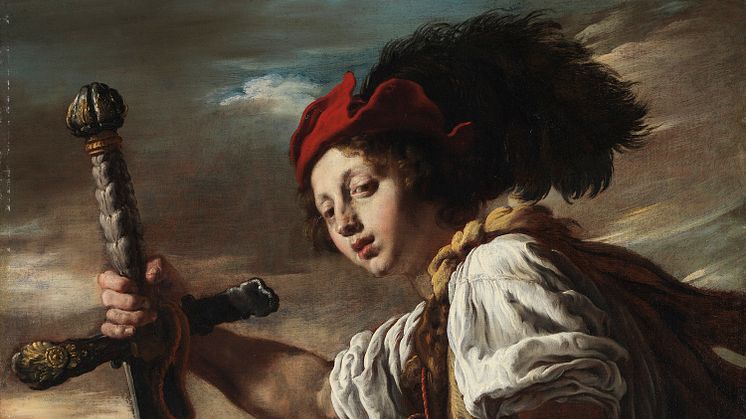
Press release -
New Acquisition: David with the Head of Goliath by Domenico Fetti
Nationalmuseum has acquired a work by Domenico Fetti, one of the truly important Italian Baroque painters. The painting comes from a Swedisg collection and has not been shown to the public since 1963. Several details strongly suggest that this was the first of the two known closely related versions of this composition, something that upcoming art technological studies will tell.
The Nationalmuseum’s collection of Italian paintingshas been augmented by the significant addition of Domenico Fetti’s David with the Head of Goliath. The artist today counts as one of the truly important Italian Baroque painters.
Domenico Fetti was born c.1588/89 in Rome, where Caravaggio’s dramatic chiaroscuro painting made a deep early impression on the young artist. In 1613 he was invited to serve as court painter to Cardinal Ferdinando Gonzaga, when the latter became Duke of Mantua. Here the artist studied works by Peter Paul Rubens, as well as those by Giulio Romano and the Venetians of the previous century, Titian and Tintoretto, whose rich colours and painterly brushwork increasingly informed his own work. In 1622 Fetti moved to Venice, where he died the following year.
During his tenure as court painter at Mantua, Fetti created this striking composition. It depicts the Old Testament story of the shepherd boy David, who triumphed over the giant Goliath, a subject earlier made popular by Caravaggio. Using a stone from his sling, David killed the champion of the Philistines and then decapitated him with his own sword. Here, at the conclusion of the drama, a triumphant David holds the massive, severed head of Goliath, grasping his hair in one hand and the oversized sword in the other. In the background, the headless corpse of the slain enemy lies upon the battlefield as the Philistines are being routed by the Israelites.
David is portrayed as a strong young man who will soon become king of Israel. He gazes down at the viewer with unwavering self-confidence as a gust of wind animates his feathered cap and the sky behind him. The cruelty of the event has been toned down in favour of a rather elegant, theatrical interpretation. Especially striking is the way Fetti accentuates David’s fanciful all’antica costume and accessories. The folds of his white linen shirt are rendered with ostentatious virtuosity, while also emphasizing the naturalism of the muscular body underneath. The swift and fluid brushwork, and the numerous pentimenti, strongly suggest that this was the first of the two known closely related versions of this composition. Interestingly, the portrait-like features of the model suggest that the image was painted in homage of one of the young princes of Mantua, thus giving it a political dimension.
This superlative painting, whichcomes from a Swedish collection, has not been shown to the public since the exhibition Konstens Venedig held at the Nationalmuseum in 1962/63. It represents an important rediscovery. The acquisition was made possible through a generous donation from the Wiros Fund. Nationalmuseum has no budget of its own for new acquisitions, but relies on gifting and financial support from private funds and foundations to enhance its collections of fine art and craft.
Press contact
Hanna Tottmar, press officer, hanna.tottmar@nationalmuseum.se, +46 767 23 46 32
Caption
Domenico Fetti, David with the Head of Goliath, c.1618/20. Photo: Cecilia Heisser/Nationalmuseum.
Categories
Nationalmuseum is Sweden’s premier museum of art and design. The collections comprise older paintings, sculpture, drawings and graphic art, and applied art and design up to the present day. The museum building is currently under renovation and scheduled to open again in 2017. In the meantime, the museum will continue its activities through collaborations, touring exhibitions and a temporary venue at the Royal Swedish Academy of Fine Arts, Fredsgatan 12, Stockholm. Nationalmuseum collaborates with Svenska Dagbladet, FCB Fältman & Malmén and Grand Hôtel Stockholm. For more information visit www.nationalmuseum.se.

